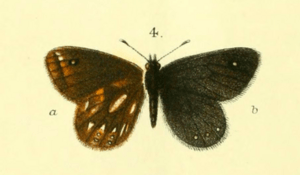Butler's ringlet facts for kids
Quick facts for kids Butler's ringlet |
|
|---|---|
 |
|
| Scientific classification |
The Butler's ringlet (Erebiola butleri) is a special butterfly. It lives only in New Zealand. This makes it an endemic species. It was first found in 1879 by John Davies Enys. He discovered it near the Rakaia River in the mountains. This butterfly is the only kind in its group, called Erebiola.
The name Erebiola comes from Erebos. This was an ancient Greek word for a dark world. The second part of its name, butleri, honors Arthur Gardiner Butler. He was a scientist from the British Museum. He helped describe many New Zealand butterflies long ago.
In the Māori language, this butterfly is called pepe pouri. This means "dark moth." It shares this name with other butterflies like the black mountain ringlet.
Contents
What Does Butler's Ringlet Look Like?
Butler's ringlet is a medium-sized butterfly. Its wings can spread about 35 to 43 millimeters wide. That's about the length of a small paperclip! Males are usually a bit bigger than females.
Both male and female butterflies are a smoky brown color. Males often have richer brown shades. Females tend to be a paler brown. If you look at the underside of their back wings, you'll see cool, silvery-white marks. These marks are shaped like wedges.
Eye-Spots and Markings
Both the top and bottom of their wings have special "eyespots." These spots are near the edges of the wings. They are surrounded by reddish-brown color. Each butterfly can look a little different. Some have more eyespots, or more reddish-brown color. The silvery-white marks on their wings also vary.
Eggs, Larvae, and Pupae
The egg of the Butler's ringlet is ivory-colored. It has vertical lines on it. The larva (caterpillar) is yellow-brown. It has dark and light stripes along its sides. A full-grown larva is about 20 millimeters long.
The pupa (chrysalis) is grey and cream. It has small black spots on its body. The rest of the pupa turns brown. Scientists are still learning how the pupa attaches itself.
The Life Cycle of the Butterfly
The female butterfly lays a single egg on a shrub. After about 14 days, the egg hatches. A tiny larva emerges from the egg.
The larva grows from 3 millimeters to 20 millimeters. We don't know exactly how long this growing stage takes. After growing, the larva changes into a pupa. The pupa stage lasts about 21 days. It's still a mystery how long the adult butterflies live.
Where Does This Butterfly Live?
The Butler's ringlet lives only in the South Island of New Zealand. You can find it in the subalpine zone. This means it lives in areas just below the high mountains. It has only been seen in a few spots along the Southern Alps.
Preferred Habitat
This butterfly likes subalpine terraces. These are flat areas on mountainsides. They are usually found at heights of 900 to 1300 meters. They prefer areas with snow-tussock grasses. They also like shrubs like Hebe and Dracophyllum.
Their favorite places are often damp, almost like a swamp. They can also be found near mountain lakes. It is very hard to find these butterflies. Because of this, we don't know their full range.
When Are They Active?
Museum records show that these butterflies are active from late December to early March. They are known to fly for long periods. They can also travel great distances.
How to Tell It Apart From Other Butterflies
Butler's ringlet looks a lot like some butterflies in the group Erebia. For a long time, it was even thought to be part of that group. But in 1967, scientists found differences in its body. So, it was given its own group, Erebiola.
Butler's Ringlet vs. Black Mountain Ringlet
The Butler's ringlet looks very similar to the black mountain ringlet (Percnodaimon pluto). But you can tell them apart by where you see them flying.
- Butler's ringlet likes to fly over plants. It rests among snow-tussock, mountain shrubs, and flowers.
- Black mountain ringlet prefers rocky areas and loose stones.

